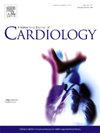Artificial intelligence-enabled electrocardiography for risk prediction in chronic liver disease: A systematic review
IF 3.2
2区 医学
Q2 CARDIAC & CARDIOVASCULAR SYSTEMS
引用次数: 0
Abstract
Background
Artificial intelligence-enabled electrocardiography (AI-ECG) has emerged as a promising tool to improve risk stratification by leveraging machine learning algorithms to detect subtle ECG abnormalities. This systematic review evaluates the performance and clinical utility of AI-ECG in risk prediction among patients with chronic liver disease (CLD).
Methods
A comprehensive literature search was conducted in PubMed, EMBASE, Cochrane Library, and Scopus databases for studies published through November 28th, 2024. Eligible studies assessed AI-enhanced ECG models for risk prediction of cirrhosis, esophageal varices and metabolic dysfunction-associated steatotic liver disease (MASLD) in patients with CLD. Relevant data on were extracted and synthesized.
Results
Four studies, encompassing 133,408 participants were included. The AI-ECG-Cirrhosis (ACE) 12‑lead ECG model was the highest performing model (AUC:0.908, sensitivity: 84.9 %, specificity: 83.2 %), followed by the convolutional neural network (CNN)-based deep learning algorithm for the detection of cirrhosis (AUC: 0.86, 95 %CI: 0.85–0.87, sensitivity: 79.5 %, specificity: 76.1 %). The Detection of Undiagnosed Liver Cirrhosis via ECG (DULCE) model in combination with platelet count for the detection of large esophageal varices (AUC: 0.636) and the ECG in combination with clinical parameters (age, sex, body mass index, diabetes mellitus, alanine aminotransferase) models for the detection of MASLD (AUC: 0.76, 95 %CI: 0.74–0.78), sensitivity: 71.9 %, specificity: 67.1 %), had lower performances. There was a positive correlation of the ACE score and MELD-Na score (Spearman's correlation coefficient r = 0.3267, p < 0.001) for the grading of cirrhosis severity.
Conclusions
AI-enabled ECG models could offer a novel non-invasive approach to early subclinical disease detection and risk stratification in patients with CLD, however, their sensitivities and specificities remain to be improved prior to routine clinical use. Future research should therefore focus on optimizing, refining, prospectively validating and standardizing these models to facilitate clinical integration.
人工智能心电图在慢性肝病风险预测中的应用:系统综述
背景:人工智能心电图(AI-ECG)已经成为一种有前途的工具,通过利用机器学习算法来检测细微的ECG异常,从而改善风险分层。本系统综述评估了AI-ECG在慢性肝病(CLD)患者风险预测中的表现和临床应用。方法:综合检索PubMed、EMBASE、Cochrane Library和Scopus数据库,检索截止到2024年11月28日发表的研究。符合条件的研究评估了人工智能增强ECG模型对CLD患者肝硬化、食管静脉曲张和代谢功能障碍相关脂肪变性肝病(MASLD)的风险预测。对相关数据进行了提取和综合。结果:纳入4项研究,共133,408名受试者。ai -ECG-肝硬化(ACE) 12导联心电图模型是表现最好的模型(AUC:0.908,灵敏度:84.9 %,特异性:83.2 %),其次是基于卷积神经网络(CNN)的肝硬化检测深度学习算法(AUC: 0.86, 95 %CI: 0.85-0.87,灵敏度:79.5 %,特异性:76.1 %)。结合血小板计数检测食管大静脉曲张(AUC: 0.636)和结合临床参数(年龄、性别、体重指数、糖尿病、丙氨酸转化酶)检测MASLD (AUC: 0.76、95 %CI: 0.74 ~ 0.78)的心电图检测未确诊肝硬化(DULCE)模型(灵敏度:71.9 %,特异性:67.1 %)表现较差。ACE评分与MELD-Na评分呈正相关(Spearman相关系数r = 0.3267,p )结论:人工智能心电图模型可以为CLD患者早期亚临床疾病检测和风险分层提供一种新的无创方法,但在常规临床应用之前,其敏感性和特异性有待提高。因此,未来的研究应侧重于优化、完善、前瞻性验证和标准化这些模型,以促进临床整合。
本文章由计算机程序翻译,如有差异,请以英文原文为准。
求助全文
约1分钟内获得全文
求助全文
来源期刊

International journal of cardiology
医学-心血管系统
CiteScore
6.80
自引率
5.70%
发文量
758
审稿时长
44 days
期刊介绍:
The International Journal of Cardiology is devoted to cardiology in the broadest sense. Both basic research and clinical papers can be submitted. The journal serves the interest of both practicing clinicians and researchers.
In addition to original papers, we are launching a range of new manuscript types, including Consensus and Position Papers, Systematic Reviews, Meta-analyses, and Short communications. Case reports are no longer acceptable. Controversial techniques, issues on health policy and social medicine are discussed and serve as useful tools for encouraging debate.
 求助内容:
求助内容: 应助结果提醒方式:
应助结果提醒方式:


